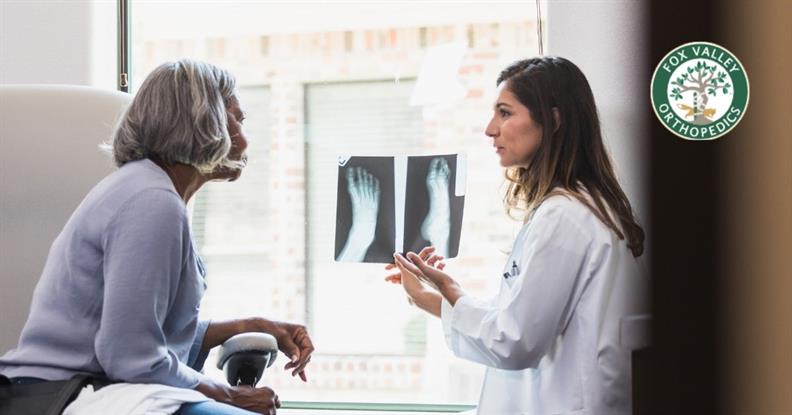Aches and Pains You Shouldn’t Ignore
- Category: Blog
- Posted On:
- Written By: Fox Valley Orthopedics

When You Shouldn’t Ignore Orthopedic Pain
While many people find themselves pushing through aches and pains, hoping they'll subside on their own—there are certain orthopedic issues that can cause more severe damage if left undiagnosed and untreated. Learn more about how you can identify these common injuries and conditions.
Hand & Wrist Injuries
The hands and wrists are made up of many small, intricate, and delicate parts that allow you to perform everyday functions. However, they are also more prone to sustaining injuries than other parts of the body. Here are some common injuries that affect the hands and wrists that should be treated by an orthopedic specialist.
Hand or Wrist Fracture
With 27 thin, delicate bones making up the hands and wrists, experiencing breaks and fractures are a fairly common occurrence because we constantly use our hands for everyday activities. When additional force is applied to these delicate bones, they have the potential to break pretty easily.
The most common bones to experience a break include:
- Phalanges (fingers)
- Metacarpal bones (hand)
- Carpal bones (wrist)
- Radius (forearm)
- Ulna (forearm)
If left undiagnosed and untreated, broken bones can cause permanent disfigurement and even loss in proper function of the affected bone.
Finger Dislocation
Dislocated fingers happen when one of the joints of your finger bone is bent backward or sideways out of its original position, forcing it out of it’s typical alignment.
The following joints in your fingers can experience dislocation as a result of injury:
- Distal interphalangeal joints
- Proximal interphalangeal joints
- Metacarpophalangeal joints
De Quervain’s Tendinitis
De Quervain’s Tendinitis is a condition that affects the tendons in the wrist as a result of chronic overuse. While this injury is most common in adults over the age of 40, it is also common amongst athletes who engage in sports that require repeated stress on the hands and wrists such as golf and rowing.
Symptoms typically include:
- Pain and swelling on the thumb-side of the wrist.
- Difficulty moving the thumb and wrist.
- Pain traveling in the wrist and up the forearm.
- Developing a cyst on the thumb-side of the wrist.
- A “catching” sensation when moving the thumb.
- Numbness on the back of the thumb and index finger.
- Difficulty lifting objects.
If tendonitis goes untreated, it can become more severe and even result in permanent damage to the affected tendons.
Foot Injuries
As a weight-bearing body part with 26 bones, 30 joints, and over 100 muscles and connective tissues, the feet have the potential to experience various injuries as a result of trauma and overuse. Here are some of the most common foot injuries that warrant a trip to your orthopedist’s office.
Stress Fracture
As weight-bearing bones on the lower half of your body, the bones in your feet are extremely prone to experiencing stress fractures. These breaks happen as a result of overuse or a sudden increase in physical activity. Typically, stress fractures affect the second and third metatarsals.
Like other broken bones, if stress fractures are left untreated, there will be an increase in pain, and your risk for developing a full break increases with time.
Plantar Fasciitis
The plantar fascia is a ligament that connects the heel to the front of the foot. When this ligament experiences excessive amounts of stress, it can become damaged, resulting in pain-causing inflammation.
If left untreated, plantar fasciitis can become a chronic condition that eventually begins to affect the knee and hip.
Achilles Tendonitis
Your Achilles tendon runs down the back of your lower leg, connecting your calf to your heel. Achilles tendonitis happens when this tendon is overused and develops pain-causing inflammation. Because you use this tendon during everyday activities like walking or jumping, it is easy to develop an overuse injury and experience degeneration.
If you hear or feel a “pop” in the back of your heel or calf, you may have sustained a tear in your Achilles tendon, which means you should see an orthopedic specialist as soon as possible.
When to Head to the Emergency Room
Although many orthopedic injuries and concerns can wait to be addressed during an appointment with your orthopedist and others can even subside on their own, certain injuries should not wait and need to be addressed as quickly as possible. This is because these injuries can result in extensive damage to the affected area if left unaddressed and untreated for too long. Here’s what you should know when it comes to identifying injuries that could potentially require emergency medical care.
Head Injuries
Whether you experience a nasty fall or have direct trauma to your head, head and neck injuries are some of the most serious orthopedic injuries you can sustain. When you hit your head or neck, you can cause damage to your brain or spinal cord, which can result in more extensive damage later on if ignored.
If you experience any of the following after a head or neck injury, dial 911 or make your way to the emergency room as quickly as possible:
- Dilated pupils.
- Visible deformity to the skull.
- Dizziness.
- Amnesia or loss of memory.
- Loss of consciousness.
- Nausea.
- Seizures.
- Lethargy.
- Clear liquid leaking from the nose or ears.
- Sudden, severe headache.
- Weakness in the limbs.
- Bruising around the eyes or behind the ears.
Fractures
Most simple fractures require urgent care from an orthopedic specialist who can properly set the bone to heal properly. However, there are specific instances when a broken bone becomes a medical emergency.
If you experience the following symptoms, you should dial 911 or go to the emergency department as quickly as possible:
- Your bone has broken through the skin or is visibly poking through the skin.
- There is apparent visual deformity to the affected area.
- You experience a loss of feeling to the affected limb.
Torn Ligaments
Ligaments help to provide support and stability to your joints. However when your joint experiences trauma, the supportive structure can be damaged and even torn. If you experience any of the following symptoms, you’ve likely experienced a completely torn ligament and require emergency medical treatment:
- Instability of the affected joint.
- Inability to bear weight on the affected joint.
- Experiencing spasms in surrounding muscles.
If left untreated, you can experience permanent damage to your joint resulting in the development of arthritis and even disfigurement.
Orthopedic Care in Fox Valley
At Fox Valley Orthopedics, we can help you get back to a pain-free, comfortable life. If you have been dealing with aches and pains that have lasted for more than a week, don’t put off getting help another day. Call (630) 584-1400 today to schedule your appointment.



